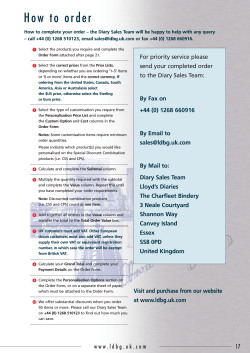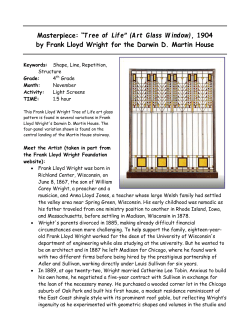
Solvency II workshop Governance, Risk Management and Use 9 & 10 September
< Picture to go here > Solvency II workshop Governance, Risk Management and Use 9 & 10 September © Lloyd’s 1 Agenda ► Introduction ► Model Change – Themes from submissions – Feedback from recent reviews ► Evidence Templates ► Planned Use Test Review Activity in Q4 ► Table discussions ► Minimum Standards update ► Next steps and Questions © Lloyd’s 2 Lloyd’s is abuzz with Solvency II activity… ► LIM IMAP submission April 2015 – Complex project plan and delivery – A number of workstreams, including the Syndicate Workstream – Additional resources – Ongoing PRA interaction in the lead up to April 2015 ► Current SCR and Validation report submissions and reviews – Key Lloyd’s process for assessing Solvency II compliance ► SAG meetings and SII agent ratings – Ongoing through September – Prudential Measures – Interaction between CPG and SAG ► PRA interaction – PRA Panel meetings for 30 agents in the sample… – …but implications for all agents © Lloyd’s 3 SAG and CPG interaction Q1 SAG assessment of agent Solvency II compliance July Solvency II ratings incorporated into CPG papers with any recommendation for prudential measures CPG input into SAG process SAG input into CPG process Q4 Annual Agent Solvency II attestation October / November SAG reconsiders agent Solvency II ratings in light of CPG findings September / October CPG review of final SCR and SBF and reconsideration of application of prudential measures July/August CPG review of draft SCR and SBF including consideration of application of prudential measures July/ August CPG feedback to agents © Lloyd’s 4 SAG and CPG interaction Q1 SAG assessment of agent Solvency II compliance July Solvency II ratings incorporated into CPG papers with any recommendation for prudential measures CPG input into SAG process SAG input into CPG process Q4 Annual Agent Solvency II attestation October / November SAG reconsiders agent Solvency II ratings in light of CPG findings September / October CPG review of final SCR and SBF and reconsideration of application of prudential measures July/August CPG review of draft SCR and SBF including consideration of application of prudential measures July/ August CPG feedback to agents September/ October SAG rating reviews © Lloyd’s 5 SAG and CPG interaction October/ November Application of prudential measures Q1 SAG assessment of agent Solvency II compliance July Solvency II ratings incorporated into CPG papers with any recommendation for prudential measures CPG input into SAG process SAG input into CPG process Q4 Annual Agent Solvency II attestation October / November SAG reconsiders agent Solvency II ratings in light of CPG findings September / October CPG review of final SCR and SBF and reconsideration of application of prudential measures July/August CPG review of draft SCR and SBF including consideration of application of prudential measures July/ August CPG feedback to agents September/ October SAG rating reviews © Lloyd’s 6 Reminder of the prudential measures ► Syndicates rated Red shall be subject to a 20% loading to the final capital assessment ► Syndicates rated Amber shall be subject to a 10% loading to the final capital assessment following the CPG process for applications for release of funds from Lloyd’s ► This will be reassessed in Q1 2015, leading to either alignment with red agents (full 20% loading for release or injection of capital), or its removal ► Application of prudential measures will be determined after final SCR and Validation reports have been submitted and reviewed but before the capital approval deadline dates – non-aligned syndicates: 24 October 2014 – aligned syndicates: 21 November 2014 © Lloyd’s 7 Lloyd’s interaction with the PRA – Managing Agents ► 2014… increased interaction with the PRA ► 30 managing agents in the sample ► PRA Panel meetings from June to October – PRA Supervisory Teams meeting with Lloyd's teams – Followed by feedback letters – In most cases, PRA will look to Lloyd’s to follow up feedback points ► Some themes: – Dependencies – Modelling methodologies – One Year SCR number & approach to Risk Emergence – Validation (governance, independence, consistency of applying policies) – Use Test © Lloyd’s 8 Lloyd’s interaction with the PRA – Lloyd's ► Increased PRA interaction at all levels of the Lloyd’s Solvency II programme – The Syndicate Workstream is material to Lloyd’s Internal Model approval – PRA need to be comfortable that Lloyd’s process is robust – We are expected to be able to justify agent SII ratings – Understand any differences of opinion – Regular fortnightly Syndicate Workstream meetings with the PRA’s LIM review team © Lloyd’s 9 December attestation requirements ► By end October Lloyd's will provide an updated schedule of SII status to each agent ► Please note the requirement to submit: – Model Change Policy – Model Scope Policy – Validation Policy – Data Management Policy ► Lloyd’s will review all agent submissions during Q1 2015 and will continue to work with agents during Q1 2015 to assess and monitor the closure of any remaining gaps in the lead up to the LIM IMAP submission in April 2015. © Lloyd’s 10 Agenda ► Introduction ► Model Change – Themes from submissions – Feedback from recent reviews ► Evidence Templates ► Planned Use Test Review Activity in Q4 ► Table discussions ► Minimum Standards update ► Next steps and Questions © Lloyd’s 11 High level observations - 2013 ► A total of 1354 model changes were reported. ► On average, 15 model changes were reported per submission. ► 80% of all submissions reported 15 changes or less. ► Four submissions contained more than 70 changes. Total Quantitative/Qualitative Changes Total Major/Minor Changes 86 6% 186 14% Qualitative Changes Major Changes Quantitative Changes 1163 86% Minor Changes 1263 94% © Lloyd’s 12 ….and what does that look like in 2014 ► A total of 2,012 model changes were reported. ► On average, 35 model changes were reported per agent. ► 40% of agents reported 15 changes or less. ► Four agents reported more than 80 changes. Total Quantitative/Qualitative Changes Total Major/Minor Changes 169 (8%) 229 (11%) Major Changes Qualitative Changes Minor Changes Quantitative Changes 1843 (92%) 1783 (89%) © Lloyd’s 13 Changes by Classification Changes by Classification 177 (9%) 80 (4%) 141 (7%) 378 (19%) Underlying Risk Profile Model Methodology Model Parameterisation Data Updates 675 (33%) Model Design Governance/Controls 561 (28%) ► Parameter changes accounted for the largest proportion of changes made (33%). ► Only 4% of model changes resulted from changes to the underlying risk profile. © Lloyd’s 14 Minor and Major Changes by Classification Minor 145 (8%) 69 (4%) 108 (6%) Underlying Risk Profile 353 (19%) Model Methodology Model Parameterisation 628 (34%) Data Updates Model Design Governance/Controls Major 540 (29%) 11 (6%) 32 (19%) 33 (20%) Underlying Risk Profile Model Methodology Model Parameterisation 25 (15%) Data Updates Model Design Governance/Controls 21 (12%) 47 (28%) © Lloyd’s 15 Qualitative versus Quantitative changes Qualitative 5 (2%) 12 (5%) 9 (4%) 2 (1%) 5 (0%) Underlying Risk Profile 349 (20%) Quantitative 75 (4%) 129 (7%) Underlying Risk Profile Model Methodology Model Methodology Model Parameterisation Model Parameterisation Data Updates Data Updates Model Design 666 (38%) Model Design 29 (13%) 172 (75%) 559 (31%) Governance/Controls Governance/Controls ► Governance/control changes accounted for 75% of the qualitative changes although, 5 governance changes were classified as quantitative changes. ► Parameter changes constituted 38% of all quantitative changes. There were 9 parameterisation changes classified as qualitative. © Lloyd’s 16 Changes outside the scope of Model Change Policy Excluded Changes by Classification 20 (4%) 21 (4%) 36 (7%) 21 (4%) Underlying Risk Profile Model Methodology Model Parameterisation Data Updates 192 (35%) Model Design 249 (46%) Governance/Controls ► 539 changes were excluded as being outside the scope of the change policies. ► There were various changes excluded with limited rationale for the exclusion. ► With the exception of data changes (192 changes - 35%), all other changes should have been included as per Lloyd’s March 2014 guidance. © Lloyd’s 17 Agenda ► Introduction ► Model Change – Themes from submissions – Feedback from recent reviews ► Evidence Templates ► Planned Use Test Review Activity in Q4 ► Table discussions ► Minimum Standards update ► Next steps and Questions © Lloyd’s 18 Timeline of activity on model change ► July 2012: – First review of the market’s model change policies & initial views on guidance developed ► July 2013 – first review of the market’s model change reports ► September 2013 – Lloyd’s meeting with the PRA, followed by publication of Interim Measures ► Q4 2013 – Model change workshops and market working group discussions ► Q1 2014 – Model change meetings with the market – Lloyd’s model change guidance & 2014 submission requirements issued July 2012 July 2013 September 2013 Q4 2013 Q1 2014 © Lloyd’s 19 2014 submission 3 July ► Model change report – all changes from date of final 2014 SCR approval in 2013 ► Model change policy, key focus on: – Change types and definitions – Approaches to batching of parameter – Combination of changes ► Documentation to show how change types map to Lloyd’s guideline definitions 16 September ► Model change report – all changes since 3 July © Lloyd’s 20 Findings from 2014 Overall approach has developed since 2013 Policies are now more consistently aligned to Solvency II requirements Qualitative considerations now more prevalent Some alternative approaches on the combination of changes presented Model change submissions far more comprehensively filled out and greater alignment to policies Better consistency with the Change Analysis produced for the LCR/SBF © Lloyd’s 21 Findings from 2014 Lloyd’s 2014 guidance not always used Key areas of feedback remain: • Combination of minor changes • Consideration of the key drivers of model change • Definition of change types and inclusion of certain change types • Approach to batching of parameters and not all changes • Approach to scope extensions remains unclear in many cases Some policies introduce non-standard change categories (e.g. trivial, insignificant) Governance of changes still requires clarity • Major changes to be approved by the Board • Completion of feedback loops following changes © Lloyd’s 22 2015 process……. ► Formal process to go live in January 2015 ► Risk Assurance manager will be contact point and central liaison for model changes ► Approval of major model changes predominantly through the Standards Assurance Group (SAG), which meets weekly ► Lloyd’s will use existing processes for notification of major changes where relevant e.g. SBF, SCR submissions, governance notifications ► Board approved Model Change policies to be submitted as part of December attestation ► Further guidance to be provided as part of the 2015 plan to include: ► Timing of quarterly submissions ► Template for Quarterly reporting and Major change submissions © Lloyd’s 23 Agenda ► Introduction ► Model Change – Themes from submissions – Feedback from recent reviews ► Evidence Templates ► Planned Use Test Review Activity in Q4 ► Table discussions ► Minimum Standards update ► Next steps and Questions © Lloyd’s 24 Update on review of Evidence Templates ► Evidence templates for GRMU workstream were submitted at end of June ► Concentrated on areas where there had been some time since our initial review work ► All templates have been reviewed and feedback will fall into the following categories: – Small points of clarification are required on the evidence template or underlying documentation. – Further work is needed, which could be an update to the evidence template ahead of the December attestation or documentation needing to be submitted and reviewed. – Significant further work is needed, which will include Lloyd’s needing to revisit a number of review areas. ► Emails containing your specific feedback will be issued in the next 2 weeks © Lloyd’s 25 Agenda ► Introduction ► Model Change – Themes from submissions – Feedback from recent reviews ► Evidence Templates ► Planned Use Test Review Activity in Q4 ► Table discussions ► Minimum Standards update ► Next steps and Questions © Lloyd’s 26 Overview of planned work in Q4 ► 3 key strands of review activity – Update of agent Use Test Questionnaire – Review of relevant Use Test documentation – Interviews with agency directors and staff (will include Non-Executive Directors, Executives and ‘Users’ of the model) ► Will include follow up on 2012 and 2013 findings ► Review activity will be in Q4 2013, but we will give indication of interviewees by end September ► Clear links to other reviews e.g. ORSA, Model Change, Validation etc. ► Use Test failings may lead to additional review activity in other areas e.g. governance, risk management etc. © Lloyd’s 27 Agenda ► Introduction ► Model Change – Themes from submissions – Feedback from recent reviews ► Evidence Templates ► Planned Use Test Review Activity in Q4 ► Table discussions ► Minimum Standards update ► Next Steps and Questions © Lloyd’s 28 Suggested discussion topics ► What developments have you undertaken in your approach to Use Test in 2014? ► What ongoing Use Test training have you conducted? ► How well embedded are your current model uses? ► Are there any new uses that you have developed? ► How have you considered Use Test requirements as part of your validation activity? © Lloyd’s 29 Agenda ► Introduction ► Model Change – Themes from submissions – Feedback from recent reviews ► Evidence Templates ► Planned Use Test Review Activity in Q4 ► Table discussions ► Minimum Standards update ► Next steps and Questions © Lloyd’s 30 Reminder of why we did this………. ► The overall objective is one Solvency II set of standards covering all requirements for Managing Agents: Internal model tests & standards & Pillars 1,2 & 3 – A clear framework within which all Managing Agents are expected to operate Claims management Risk management – Consistency in interpretation, presentation and publication – Alignment to Solvency II Underwriting management Brand & reputation Management of investment risk Governance Effective operational processes © Lloyd’s 31 …..and this is how it looks now MINIMUM STANDARDS CODE NAME MS1 Underwriting Management MS2 Claims Management MS3 Governance MS4 Risk Management MS5 Scope, Change and Use MS6 Modelling, Design and Implementation MS7 Validation MS8 Investment Management MS9 Reserving MS10 Regulatory MS11 Conduct Risk MS12 Operating at Lloyd’s © Lloyd’s 32 Existing standards that have been refreshed Key Areas • Opportunity for the appropriateness of these standards to be reconsidered. Governance • Relevant Solvency II requirements added to existing standards. • Formalisation of a number of areas of general market practice e.g. requirement for two independent non-executive directors. • System of governance • Organisational Structure • Board Effectiveness • Fit and Proper • Outsourcing • Required Functions • Remuneration Policy Key Areas • Opportunity for the appropriateness of these standards to be reconsidered. • Risk Management Risk Management • Significant Solvency II requirements added to existing standards. • Risk Governance • A number of additional Solvency II sections added e.g. ORSA. • Risk Processes • Own Risk and Solvency Assessment System © Lloyd’s 33 Standards driven by Solvency II requirements • Developed to reflect the relevant Solvency II requirements. Scope, change and use • Qualitative aspects of internal model covering: • • • Internal Model Scope Model change Use of the model • Key to how the output of the model is used and reported throughout the business. Key Areas • Internal model scope • External models and data • Use Test • Model Change • Documentation Other new standards Key Areas • Replaces the previous Operational Processes standard. Operating at Lloyd’s • Covers any organisational element of a Managing Agent which are not covered by other Lloyd’s standard. • For example, HR, IT etc. • IT Security and Infrastructure • Operational Processes • Finance • Human Resources • Reporting • Brand and Reputation © Lloyd’s 34 Compliance with standards ► Launch 1 July 2014 versus 1 January 2015 compliance ► No change in the requirement to meet those standards which have just been updated ► What does failure to meet a standard mean? – Regulatory vs Solvency II – Regular review by SAG ► Planned self-assessments in these areas will be communicated as part of our 2015 plan. © Lloyd’s 35 Current minimum standards under review ► MS1 (Underwriting) and MS2 (Claims) – self assessments spreadsheets issued Monday 3 September – workshops 12 September and 3 October – submission of completed self assessments by 1pm 24 October ► Conduct Risk (MS11) – kick off session held 3 September – workshops on 23 and 26 September specifically looking at “assessing and recording conduct risk” – self-assessment to be issued early November © Lloyd’s 36 Agenda ► Introduction ► Model Change – Themes from submissions – Feedback from recent reviews ► Evidence Templates ► Planned Use Test Review Activity in Q4 ► Table discussions ► Minimum Standards update ► Next steps and Questions © Lloyd’s 37 Next Steps ► Slides will be made available on lloyds.com after both sessions ► SCR submissions – 16 September ► Validation Report submissions – 23 September ► Directors’ briefing – 22 September ► Resubmissions (Model Change, ORSA, Actuarial Function Reports etc) – September to November ► Updated SII status schedule – sent to agents by end October ► Board attestation submissions – 12 December 38 © Lloyd’s 38 © Lloyd’s 39
© Copyright 2025










